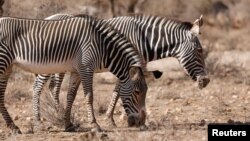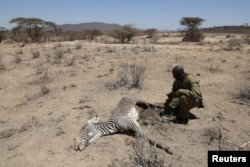Kenya's worst dry weather in forty years has killed almost two percent of the world's rarest zebra in three months. Over the same period, 25 times more elephants died than usual, as well.
The drought is starving Kenya's famed wildlife of usual food sources and driving them closer to population centers. The ever-widening search for food can result in deadly conflict between animals and people.
Without interventions to protect wildlife or rain, animals in many parts of the East African country could face a crisis, conservationists say.
"It's a serious threat to us," said Andrew Letura, an animal observation officer at Grevy's Zebra Trust (GZT). The Grevy's zebra is larger than a standard plains zebra and has narrower stripes and wider ears. They are the rarest of zebra species: just 3,000 remain in the world --- 2,500 of which are in Kenya.
Drought has killed about 40 Grevy's since June - which is how many would be expected to die over a whole year, said Letura. He spoke to Reuters at the Samburu National Reserve in northern Kenya.
"If we are losing 40 within three months, what would that mean to the remaining population?” he asked.
GZT has begun to feed Grevy's zebras hay poured over a mix of molasses, salt and calcium, helping to reduce the number of deaths, the trust says.
The situation in southern Kenya is also bad.
"Rangers have counted eight times as many animals dead or too weak to stand, compared to a normal September. The Amboseli Trust for Elephants have recorded 50 elephants dead or missing," said Benson Leyian, the chief of Big Life Foundation. The group works with local landowners to protect conservation areas and open rangelands of the Amboseli Ecosystem.
The smell of death
In the Kitenden Conservancy nearby, the smell from dead animals is strong. It sometimes leads visitors to wear face covers, a Conservancy officer said.
Some wild animals are dying at the hands of people.
"We're seeing a five-fold increase in incidents of people poaching for bushmeat, as compared to other dry seasons," Leyian said.
Another group, Save the Elephants, said it is finding a growing number of elephants killed by guns or spears, but with their tusks in place. The tusks are what poachers sell. So, experts say these elephant deaths were due to conflict with local people, not poaching.
The crisis is not the result of drought alone, experts say. Large numbers of farm animals are eating up rangelands, said David Daballen, field operations chief for Save the Elephants. He added that the lack of grasses makes it harder for ecosystems to recover from drought.
The next usual seasonal rains are from October through November. Letura of GZT does not want to think of the possibility that the rain might not come.
"The situation is already bad. But that would make it a serious crisis," he said. "The first words anyone says now is that they are praying for rain."
I’m Caty Weaver.
Ayenat Mersie reported this story for Reuters. Caty Weaver adapted it for VOA Learning English.
______________________________________________________________________
Words in This Story
rangeland – n. an open region over which animals (such as livestock) may roam and feed
spear – n. a thrusting or throwing weapon with long shaft and sharp head or blade
bushmeat – n. meat from wild animals, especially in Africa and Asia
tusk – n. a very long large tooth (as of an elephant or walrus) that sticks out when the mouth is closed and is used especially in digging and fighting
poach – v. to hunt or fish unlawfully
_______________________________________________________________________
We want to hear from you. What did you think of this story? In the Comments section, you can also practice using any of the vocabulary or expressions from the story.
We have a new comment system. Here is how it works:
Write your comment in the box.
Under the box, you can see four images for social media accounts. They are for Disqus, Facebook, Twitter and Google.
Click on one image and a box appears. Enter the login for your social media account. Or you may create one on the Disqus system. It is the blue circle with “D” on it. It is free.
Each time you return to comment on the Learning English site, you can use your account and see your comments and replies to them. Our comment policy is here.



Forum